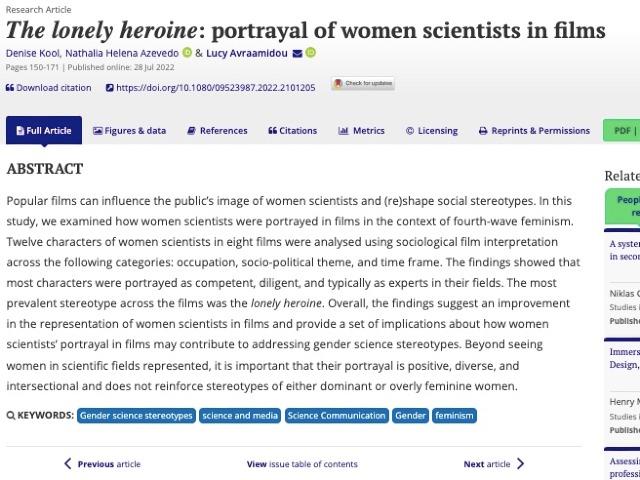Open Access Publication in the Spotlight (September) - 'The lonely heroine: portrayal of women scientists in films'
| Date: | 19 September 2022 |
| Author: | Open Access Team |

Each month, the open access team of the University of Groningen Library (UB) puts a recent open access article by UG authors in the spotlight. This publication is highlighted via social media and the library’s newsletter and website.
The article in the spotlight for the month of September 2022 is titled The lonely heroine: portrayal of women scientists in films, written by Denise Kool, Nathalia Helena Azevedo and Lucy Avraamidou (Institute for Science Education and Communication, Faculty of Science and Engineering).
Abstract
Popular films can influence the public’s image of women scientists and (re)shape social stereotypes. In this study, we examined how women scientists were portrayed in films in the context of fourth-wave feminism. Twelve characters of women scientists in eight films were analysed using sociological film interpretation across the following categories: occupation, socio-political theme, and time frame. The findings showed that most characters were portrayed as competent, diligent, and typically as experts in their fields. The most prevalent stereotype across the films was the lonely heroine. Overall, the findings suggest an improvement in the representation of women scientists in films and provide a set of implications about how women scientists’ portrayal in films may contribute to addressing gender science stereotypes. Beyond seeing women in scientific fields represented, it is important that their portrayal is positive, diverse, and intersectional and does not reinforce stereotypes of either dominant or overly feminine women.
We asked the authors a few questions about the article:
How important is open science to the field of science education and communication?
Nathalia: Open science reflects the dynamic interaction between knowledge production and dissemination in science education and communication, which is a form of ‘socialization of the scientific output’. The importance of the socialization of scientific output is reflected on at least two fronts. First, as a principle of science, which is strengthened when knowledge is more open and when there are more diverse contributions between individuals and disciplines. Second, we can think of its importance in terms of impact. Particularly for science education and communication, we aspire to see evidence in research shape both policy and teaching practice. In the case of our study, for example, knowing that there is a need for diversifying the representation of women in science in films is useful not only to researchers in the field of science education and communication. It is also relevant for anyone interested in making science more relatable and accessible: policy makers, curriculum designers, researchers in both social sciences and natural sciences, as well as those in the field of public engagement with science.
To what extent is open science part of the curriculum at the Institute for Science Institute for Science Education and Communication (ISEC) ?
Lucy: Open science is part of all activities of ISEC which include curriculum design, teaching, and research. We strive to make our work freely available and accessible for the purpose of reaching a wider audience through overcoming unjust barriers connected to paywalls. Our position is that open science has the potential to democratize scholarly knowledge and contribute towards socially just publishing procedures.
Who is your favourite female movie scientist heroine? And why?
Denise: My favorite characters are the ones that show complexity, their humanity and embody traits I like to see in myself and others, like resilience and curiosity. While all heroines we studied embodied those traits in their own way, I loved the portrayal of Dorothy Vaughn, Katherine Johnson and Mary Jackson in Hidden Figures the most. The way they exceeded the expectations of their environment and took control of their stories was something that was very inspiring to me.
Could you reflect on your experiences with open access and open science in general?
Lucy: Nothing but love at a first level. However, there are 3 dangers embedded in open science in my view: a) the possibility of mis-information in relation to pre-publication of not-reviewed studies, as we witnessed especially during COVID-19 pandemic; b) it makes scientists vulnerable and exposed to hate speech especially those who are not trained to engage with the public; c) it nurtures the neoliberal global game of measurements, citations, and metrics that are not necessarily or always connected to quality and impact.
Useful links:
Institute for Science Education and Communication (ISEC): Overview of vision, goals, and research projects
Hidden Figures: movie trailer
Citation:
Denise Kool, Nathalia Helena Azevedo & Lucy Avraamidou (2022) The lonely heroine: portrayal of women scientists in films, Educational Media International, 59:2, 150-171, DOI: 10.1080/09523987.2022.2101205
If you would like us to highlight your open access publication here, please get in touch with us.


